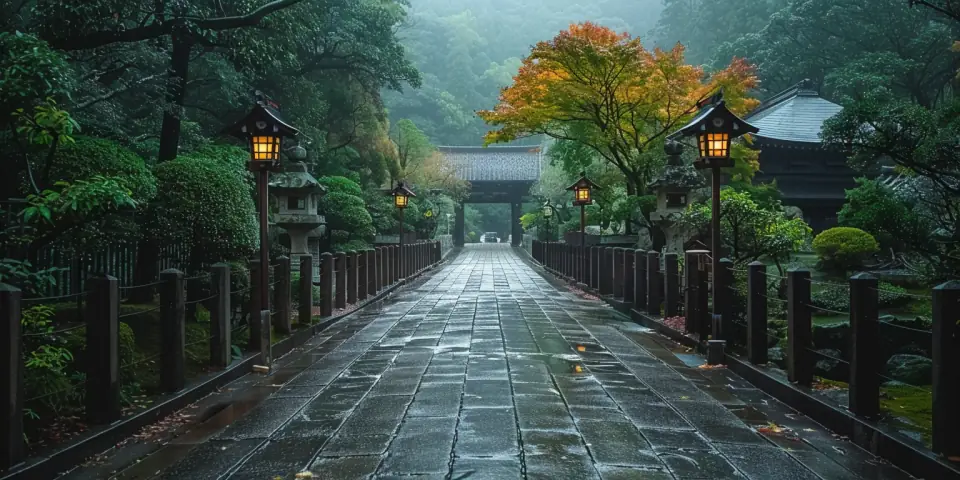
The Art and Philosophy of Japanese Gardens
Environmental Considerations in Japanese Gardens
As we delve deeper into the world of Japanese gardens, it becomes evident that these meticulously crafted landscapes are more than just visually appealing – they embody centuries-old philosophies that emphasize harmony, balance, and simplicity. One of the most significant aspects of Japanese garden design is its deep connection with environmental stewardship.
When creating a Japanese-inspired garden, it’s essential to prioritize natural materials and processes. This can be achieved by selecting native plants that thrive in local ecosystems, promoting biodiversity and supporting local wildlife. Additionally, incorporating sustainable practices such as rainwater harvesting and composting can significantly enhance the ecological benefits of your garden.
To create a habitat that supports local species, consider thoughtfully selecting plants that provide food and shelter for birds, insects, and small mammals. Water features, such as ponds or streams, can be designed to mimic natural habitats, providing a haven for aquatic life. Rock arrangements can also be crafted to create microhabitats, supporting a diverse range of flora and fauna.
As you embark on designing your Japanese-inspired garden, remember that every element has purpose and meaning. The stones anchor the space, the water reflects both sky and surroundings, and the plants add texture and life. By embracing simplicity, subtlety, and depth, you can create an environment where every component works in harmony to promote contemplation, spiritual growth, and environmental stewardship.
To ensure your garden remains a tranquil oasis, maintain it regularly by pruning plants, cleaning water features, and rearranging rocks as needed. This will not only preserve the aesthetic beauty of your garden but also support the local ecosystem.
By embracing the principles of Japanese garden design, you can create a serene and sustainable space that inspires harmony between nature and culture. As you tend to your garden, remember that every action has an impact on the environment, and strive to make conscious choices that promote biodiversity conservation and ecological citizenship.
The Assembly of Stones, Water, and Plants
Embracing Harmony: Creating a Sustainable Japanese-Inspired Garden
As we explore the world of Japanese gardens, it becomes clear that these meticulously crafted landscapes embody centuries-old philosophies emphasizing harmony, balance, and simplicity. One of the most significant aspects of Japanese garden design is its deep connection with environmental stewardship.
When creating a Japanese-inspired garden, prioritize natural materials and processes. Select native plants that thrive in local ecosystems, promoting biodiversity and supporting local wildlife. Incorporate sustainable practices like rainwater harvesting and composting to enhance ecological benefits. Consider thoughtfully selecting plants that provide food and shelter for birds, insects, and small mammals. Water features can be designed to mimic natural habitats, providing a haven for aquatic life.
To create a habitat that supports local species, design rock arrangements to craft microhabitats, supporting diverse flora and fauna. Remember, every element has purpose and meaning: stones anchor the space, water reflects both sky and surroundings, and plants add texture and life. By embracing simplicity, subtlety, and depth, you can create an environment where every component works in harmony.
To maintain your tranquil oasis, regularly prune plants, clean water features, and rearrange rocks as needed. This preserves aesthetic beauty while supporting the local ecosystem. Embracing Japanese garden design principles allows you to create a serene and sustainable space inspiring harmony between nature and culture.
As you tend to your garden, remember that every action has an environmental impact. Make conscious choices promoting biodiversity conservation and ecological citizenship. Consider the following tips:
- Select plants native to your region to support local ecosystems.
- Incorporate rainwater harvesting and composting to reduce waste and conserve resources.
- Design water features to mimic natural habitats, providing a haven for aquatic life.
- Create microhabitats using rock arrangements to support diverse flora and fauna.
By embracing these principles and tips, you can create a harmonious space that inspires contemplation, spiritual growth, and environmental stewardship.
Influence on Biodiversity and Ecosystem Conservation
Embracing Harmony: Creating a Sustainable Japanese-Inspired Garden
As we delve into the world of Japanese gardens, it becomes clear that these meticulously crafted landscapes embody centuries-old philosophies emphasizing harmony, balance, and simplicity. One of the most significant aspects of Japanese garden design is its deep connection with environmental stewardship.
When creating a Japanese-inspired garden, prioritize natural materials and processes. Select native plants that thrive in local ecosystems, promoting biodiversity and supporting local wildlife. Incorporate sustainable practices like rainwater harvesting and composting to enhance ecological benefits. Consider thoughtfully selecting plants that provide food and shelter for birds, insects, and small mammals. Water features can be designed to mimic natural habitats, providing a haven for aquatic life.
To create a habitat that supports local species, design rock arrangements to craft microhabitats, supporting diverse flora and fauna. Remember, every element has purpose and meaning: stones anchor the space, water reflects both sky and surroundings, and plants add texture and life. By embracing simplicity, subtlety, and depth, you can create an environment where every component works in harmony.
To maintain your tranquil oasis, regularly prune plants, clean water features, and rearrange rocks as needed. This preserves aesthetic beauty while supporting the local ecosystem. Embracing Japanese garden design principles allows you to create a serene and sustainable space inspiring harmony between nature and culture.
As you tend to your garden, remember that every action has an environmental impact. Make conscious choices promoting biodiversity conservation and ecological citizenship. Consider the following tips:
- Select plants native to your region to support local ecosystems.
- Incorporate rainwater harvesting and composting to reduce waste and conserve resources.
- Design water features to mimic natural habitats, providing a haven for aquatic life.
- Create microhabitats using rock arrangements to support diverse flora and fauna.
By embracing these principles and tips, you can create a harmonious space that inspires contemplation, spiritual growth, and environmental stewardship.
Recent Posts
- The Evolution of Mask Mandates in Japan Jul 8, 2024
- Exploring Japan's Kaiju Culture and Cinema Jul 8, 2024
- Shinto Elements and Environmental Ethics in Miyazaki's Films Jul 8, 2024
- Exploring Tokyo's Robot Culture: A Guide to the City's Technological Marvels and Cultural Heritage Jul 8, 2024
- Exploring Japan's Haunted Towns and Villages Jul 8, 2024
- Immersing in Tradition: A Guide to Family-Friendly Activities in Asakusa Jul 8, 2024
- Exploring Tokyo's Craft Beer Scene Jul 8, 2024
- Understanding the Bushido Code and its Impact on Modern Japanese Society Jul 8, 2024
- Traditional Calligraphy Meets Modern Osaka: A Cultural Experience Jul 8, 2024
- Exploring Visual Kei Culture in Tokyo's Live Houses Jul 8, 2024
